六年级英语下册 Unit SectionB 3a-self check课后作业及答案
- 格式:doc
- 大小:23.00 KB
- 文档页数:2
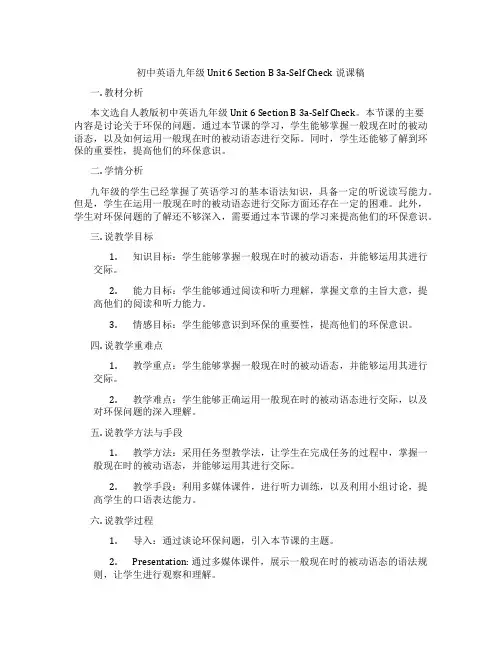
初中英语九年级 Unit 6 Section B 3a-Self Check说课稿一. 教材分析本文选自人教版初中英语九年级Unit 6 Section B 3a-Self Check。
本节课的主要内容是讨论关于环保的问题。
通过本节课的学习,学生能够掌握一般现在时的被动语态,以及如何运用一般现在时的被动语态进行交际。
同时,学生还能够了解到环保的重要性,提高他们的环保意识。
二. 学情分析九年级的学生已经掌握了英语学习的基本语法知识,具备一定的听说读写能力。
但是,学生在运用一般现在时的被动语态进行交际方面还存在一定的困难。
此外,学生对环保问题的了解还不够深入,需要通过本节课的学习来提高他们的环保意识。
三. 说教学目标1.知识目标:学生能够掌握一般现在时的被动语态,并能够运用其进行交际。
2.能力目标:学生能够通过阅读和听力理解,掌握文章的主旨大意,提高他们的阅读和听力能力。
3.情感目标:学生能够意识到环保的重要性,提高他们的环保意识。
四. 说教学重难点1.教学重点:学生能够掌握一般现在时的被动语态,并能够运用其进行交际。
2.教学难点:学生能够正确运用一般现在时的被动语态进行交际,以及对环保问题的深入理解。
五. 说教学方法与手段1.教学方法:采用任务型教学法,让学生在完成任务的过程中,掌握一般现在时的被动语态,并能够运用其进行交际。
2.教学手段:利用多媒体课件,进行听力训练,以及利用小组讨论,提高学生的口语表达能力。
六. 说教学过程1.导入:通过谈论环保问题,引入本节课的主题。
2.Presentation: 通过多媒体课件,展示一般现在时的被动语态的语法规则,让学生进行观察和理解。
3.Practice: 通过听力训练,让学生练习一般现在时的被动语态,并能够运用其进行交际。
4.Production: 学生进行小组讨论,讨论环保问题,并运用一般现在时的被动语态进行表达。
5.总结:教师对学生的表现进行点评,对一般现在时的被动语态进行总结。

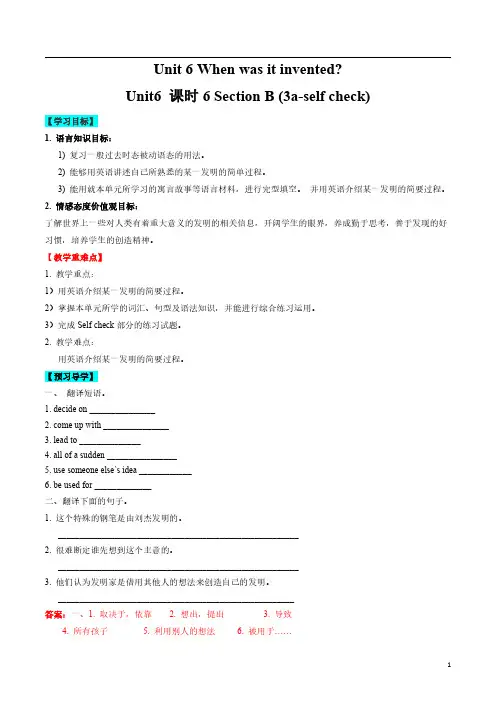
Unit6When was it invented?Unit6课时6Section B(3a-self check)【学习目标】1.语言知识目标:1)复习一般过去时态被动语态的用法。
2)能够用英语讲述自己所熟悉的某一发明的简单过程。
3)能用就本单元所学习的寓言故事等语言材料,进行完型填空。
并用英语介绍某一发明的简要过程。
2.情感态度价值观目标:了解世界上一些对人类有着重大意义的发明的相关信息,开阔学生的眼界,养成勤于思考,善于发现的好习惯,培养学生的创造精神。
【教学重难点】1.教学重点:1)用英语介绍某一发明的简要过程。
2)掌握本单元所学的词汇、句型及语法知识,并能进行综合练习运用。
3)完成Self check部分的练习试题。
2.教学难点:用英语介绍某一发明的简要过程。
【预习导学】一、翻译短语。
1.decide on_______________e up with_______________3.lead to______________4.all of a sudden________________e someone else’s idea____________6.be used for_____________二、翻译下面的句子。
1.这个特殊的钢笔是由刘杰发明的。
_______________________________________________________2.很难断定谁先想到这个主意的。
_______________________________________________________3.他们认为发明家是借用其他人的想法来创造自己的发明。
______________________________________________________答案:一、1.取决于,依靠 2.想出,提出 3.导致4.所有孩子5.利用别人的想法6.被用于……二、1.This special pen was invented by Liu Jie.2.It's hard to tell who thought of the idea first.3.They think that inventors borrow other people's ideas to create their own inventions.【探究提升】一、复习重点句型1.I think the TV was invented before the car.我认为电视是在轿车之前发明的。
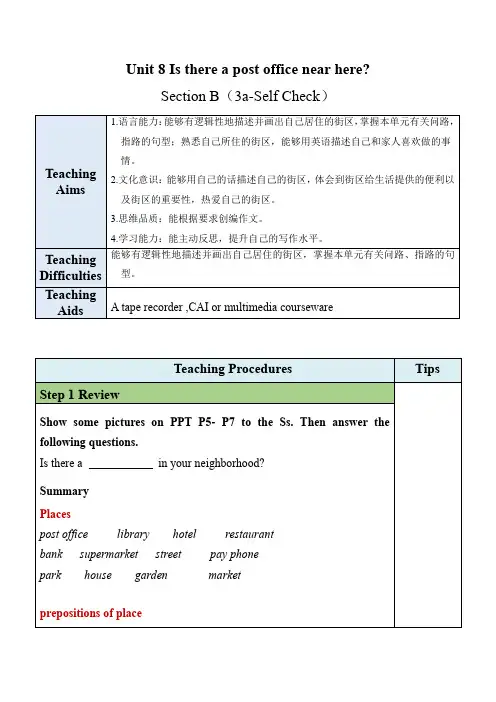
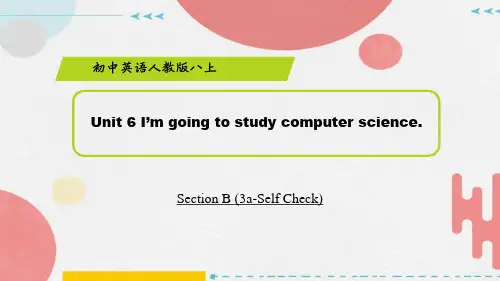
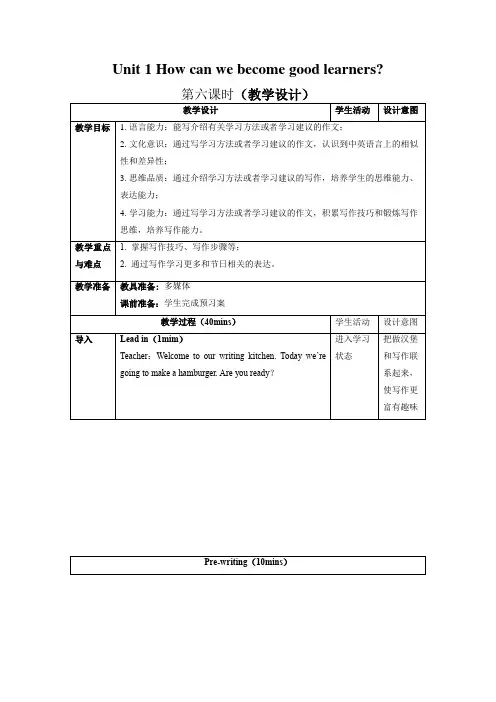
Unit 1 How can we become good learners?教学设计学生活动设计意图教学目标 1.语言能力:能写介绍有关学习方法或者学习建议的作文;2.文化意识:通过写学习方法或者学习建议的作文,认识到中英语言上的相似性和差异性;3.思维品质:通过介绍学习方法或者学习建议的写作,培养学生的思维能力、表达能力;4.学习能力:通过写学习方法或者学习建议的作文,积累写作技巧和锻炼写作思维,培养写作能力。
教学重点与难点1. 掌握写作技巧、写作步骤等;2. 通过写作学习更多和节日相关的表达。
教学准备教具准备: 多媒体课前准备:学生完成预习案教学过程(40mins)学生活动设计意图导入Lead in(1mim)Teacher:Welcome to our writing kitchen. Today we’regoing to make a hamburger. Are you ready?进入学习状态把做汉堡和写作联系起来,使写作更富有趣味Pre-writing(10mins)写前Step 1:Learn the taskTeacher:Today we’re going to write a composition. Havea look at the materiel. We need to make a hamburger. Howto make it?Students:...Step 2:Guide to make a hamburgerTeacher:Great!We need to focus on while we are writing,the subject is based on the second person and the firstperson. And we use simple present tense. And the mainpoints are about the methods of learning. How do weknow?Step 3:Find the details from the materialTeacher:Let’s come back to the material. We can get theinformation about first person from “你”,and get the tensefrom “初中学习生活”,introducing the methods oflearning at present.Step 4:PreparationTeacher:To make a hamburger, we need two pieces ofbread, one refers to writing genre, the other refers towriting structure and ...Teacher:OK, let’s begin.根据老师的提问结合材料,回答问题把做汉堡的准备过程和写作前的准备结合起来,更形象生动的展示写作的步骤While-writing(15mins)写中Analyze the materialStep 1:Make sure the genre(1min)Teacher:We can learn the genre from “写一篇短文投稿”. It’s description, Introduce the methods of learning.Students:...Step 2:Make sure the structure(1min)Teacher:The structure can be divided into three parts ortwo parts. The beginning is beginning, Introduce themethods of subject. The second part is body, introducingthe main methods. The last past in the ending, summarizesthe above.Step 3:Add the words and phrases(5mins)Step 4:Add the sentence structures(2mins)Step 5:Add the complex sentence(2mins)Step 6:Add the sayings(2mins)Step 7:Check the grammar knowledge(2mins)根据老师的提问结合材料,回答问题把做汉堡的过程和写作的过程联系起来,更形象生动的展示写作的步骤Post-writing(10mins)写后Step 1:Taste the hamburger.Step 2:Finish the activities.(4mins)1 Fill in the blanks with the words in the box.2 Number these sentences in order to make a conversation.3 Give advice to these people.完成课文的练习。

一、单项选择1.It’s ________ to go into the room without knocking at the door.A.impossible B.possible C.impolite D.polite2.I’ll never forget the place ________ we visited together last year.A.which B.what C.who D.whom 3.Doctors and nurses wear a special kind of clothes ________ can protect themselves in the hospital.A.whom B.who C.what D.which 4.Wuhan is in trouble, ________ the people of the whole country give them a hand. A.luckily B.quietly C.especially D.politely 5.—About 30 thousand visitors came to Baokang in Qingming holiday.—So it is ________ us to keep our city clean and tidy.A.harmful for B.good with C.convenient to D.necessary for二、完型填空If you ask people of different countries “Could you tell me the way to the post office?”, you will get 6 answers.In Japan, people 7 landmarks(路标) instead of street names. For example, the Japanese will say to travelers ,“Go straight down to the corner, 8 left at the big hotel and go past a fruit market. The post office is across 9 the bus stop.”In Kansas, America, there are 10 towns or buildings within(在……之内) miles. So instead of landmarks, people will tell you directions and 11 . 12 example, people will say, “Go north two miles (英里). Turn 13 , and then go another mile.”People in Greece sometimes do not even try to give 14 because few visitors15 the Greek language. They will often say, “Follow me.” Then he or she will take you16 the streets of the city to the post office. Sometimes 17 a person doesn’t know the answer to your question, he or she, like a New Yorker, might say, “Sorry, I have no18 .”But in Y ucatan, Mexico, no one answers “I don’t know.” People there think “I don’t know” is not 19 . They usually give an answer, but often a 20 one. A visitor can often get lost in Yucatan !7.A.use B.make C.look D.break 8.A.run B.choose C.turn D.take 9.A.on B.from C.to D.at 10.A.many B.any C.some D.no 11.A.landmarks B.distance C.length D.roads 12.A.For B.As C.Such D.Or 13.A.around B.back C.on D.east 14.A.directions B.present C.person D.meals 15.A.talk B.understand C.remember D.like 16.A.over B.on C.through D.by 17.A.how B.if C.why D.whether 18.A.point B.reason C.aim D.idea 19.A.bad B.well C.polite D.healthy 20.A.right B.polite C.kind D.wrong三、根据汉语提示填空21.You’d better not leave your exact _________(地址)online unless it’s an official website. 22.He’s a nice boy. He always talks to others ______( 礼貌地) .23.Many people speak highly of Hi, Mom! — a new film ________ (导演) by Jia Ling. 24.There is a mistake in the notebook, you should ________ (改正) it.25.Does the radio say the road is closed in both d________(方向) because of the heavy fog?四、多任务混合阅读Just as in face-to-face communication, there are some basic rules of behavior that should be followed on the Internet. The basic rule is simple: (1)treat others in the same way you would want to be treated. Imagine how you'd feel if you were in the other person's shoes.For anything you're about to send, ask yourself, "Would I say that to the person's face?" If the answer is no, rewrite and reread. If someone in the chat room is rude to you, you needn't fire back. You should either ignore(不理睬) the person, or use your chat software to block his or her messages. Remember to respect the beliefs and opinions of others in the chat room.Everyone was new to the network once. Offer advice when asked by newcomers, as theyabout it. If you do decide to tell someone about the mistake, point it out politely. At the same time, if you find you are wrong, be sure to correct yourself and apologize to those that you have offended(冒犯). (2)It is ________ to ask others ________ questions such as their age, sex and family. Unless you know the person very well or you are both comfortable with sharing personal information, don't ask such questions.26.将画线句子(1)译成中文。
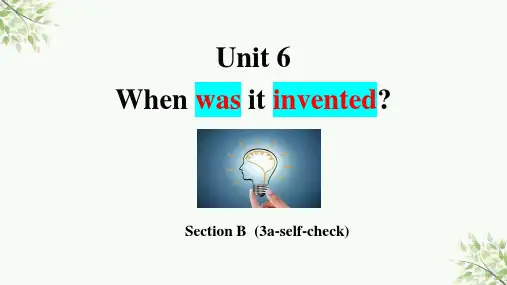
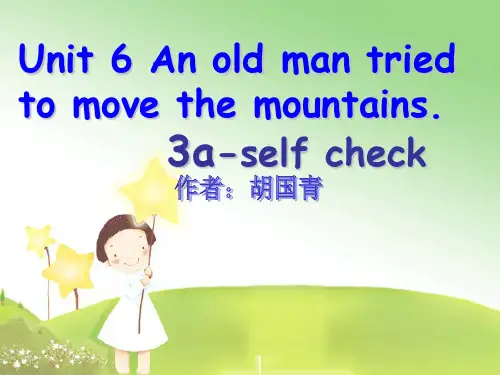
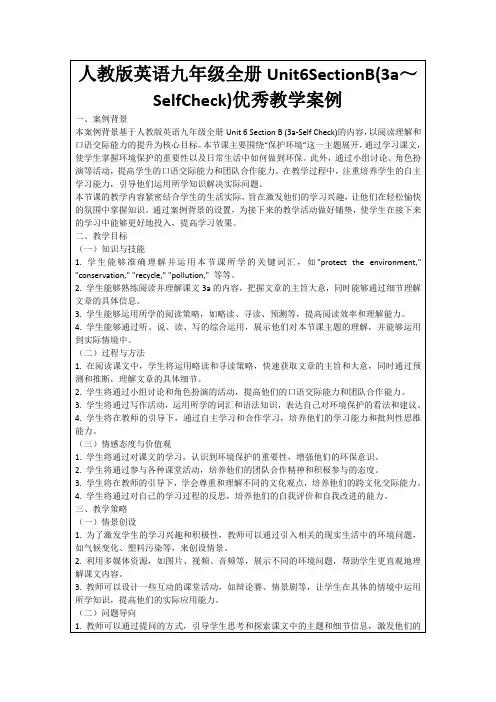
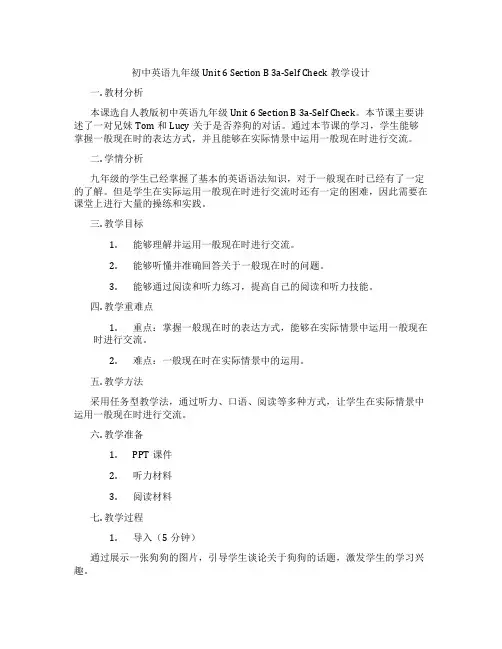
初中英语九年级 Unit 6 Section B 3a-Self Check教学设计一. 教材分析本课选自人教版初中英语九年级Unit 6 Section B 3a-Self Check。
本节课主要讲述了一对兄妹Tom和Lucy关于是否养狗的对话。
通过本节课的学习,学生能够掌握一般现在时的表达方式,并且能够在实际情景中运用一般现在时进行交流。
二. 学情分析九年级的学生已经掌握了基本的英语语法知识,对于一般现在时已经有了一定的了解。
但是学生在实际运用一般现在时进行交流时还有一定的困难,因此需要在课堂上进行大量的操练和实践。
三. 教学目标1.能够理解并运用一般现在时进行交流。
2.能够听懂并准确回答关于一般现在时的问题。
3.能够通过阅读和听力练习,提高自己的阅读和听力技能。
四. 教学重难点1.重点:掌握一般现在时的表达方式,能够在实际情景中运用一般现在时进行交流。
2.难点:一般现在时在实际情景中的运用。
五. 教学方法采用任务型教学法,通过听力、口语、阅读等多种方式,让学生在实际情景中运用一般现在时进行交流。
六. 教学准备1.PPT课件2.听力材料3.阅读材料七. 教学过程1.导入(5分钟)通过展示一张狗狗的图片,引导学生谈论关于狗狗的话题,激发学生的学习兴趣。
2.呈现(10分钟)展示本节课的主要内容,即Tom和Lucy的对话。
让学生听懂对话内容,并回答相关问题。
3.操练(15分钟)通过小组活动,让学生模拟对话中的情景,进行角色扮演,练习一般现在时的表达方式。
4.巩固(10分钟)让学生完成练习题,检测学生对一般现在时的掌握情况。
同时,教师对学生的答案进行反馈和指导。
5.拓展(10分钟)让学生阅读一篇关于养狗的文章,并回答相关问题。
通过阅读,提高学生的阅读技能,并进一步巩固一般现在时的表达方式。
6.小结(5分钟)教师对本节课的内容进行小结,强调一般现在时的表达方式和实际运用。
7.家庭作业(5分钟)布置相关作业,让学生巩固本节课所学内容,并准备下一节课的预习。
一、补全对话A: Can you tell me 1 you get to school?B: Well, I usually leave home 2 about 7: 30 and walk to the bus stop.Then the school bus comes at about 7: 40.A: 3 4 is your home from school?B: It’s about 20 kilometers.A: 5 6 does it take you to get to school by bus?B: It takes about half an hour.A: 7 is your trip to school?B: Oh, it’s interesting8 I always talk with my classmates.What 9 you?A: Oh, I 10 my bike to school. My home isn’t far f rom school.二、按照要求完成句子1. My aunt walked to the supermarket yesterday. (改为同义句)My aunt went to the supermarket ____ _____ yesterday.2. The girl usually goes to work on a bus. (同上)The girl usually goes to work ____ _____.The girl usually _____ ____ _____ ____ work.3. I go to the station in a taxi this morning. (对画线部分提问)_____ ____ _____ ____ to the station this morning?4. It’s 20 kilometers from my home to my school. (同上)____ ____ ___ ___ _____ your home ____ your school?5. It takes her two hours to get there. (同上)_____ _____ _____ it _____ her to get there?6.Eric, rides/to/school/every/his/day (连词成句)_________________________________.7. Mary goes to school by bike? (划线部分提问)________________________________?三、阅读表达AnnaI work in a bank(银行) from Monday to Friday. My house is near a park and is about tenkilometers from my office(办公室). I usually go to work by train. I usually get up at 6:30 am and take the train at 7 am. It usually takes me about thirty minutes to get to my office. The train is quick and cheap. I am never late for work.JoeI am a student. My house is near a beautiful lake. My school is across from the lake. Ican walk to school across a bridge. It takes me about thirty minutes. But I often go to school by boat, because it is more fun. It takes me about twenty minutes.NancyI’m a waiter(服务员). I work in a restaurant(餐馆) from Monday to Saturday. I often go to work by bus. It is about five kilometers from my house to the restaurant. It takes me about twenty-five minutes to go to work. Sometimes I am late for work because the traffic is very busy.1. Anna usually arrives at her office at about ______.A. 6:30 amB. 7 amC. 7:30 amD. 8 am2. Joe often ______ to school.A. takes a busB. takes a trainC. walksD. takes a boat3. Nancy lives about ______ kilometers from her working place.A. fiveB. tenC. fifteenD. twenty4. The underlined(加下划线的) word "traffic" means(意思是) "______"in Chinese.A. 餐馆B. 交通C. 市场D. 车站5. Which of the following(下列的) is TRUE according to(根据) the passage(文章)?A. Anna is sometimes late for work.B. Joe lives near a river.C. Nancy works five days a week.D. Three of them go out (外出) by different means of transportation(不同的交通方式). 答案解析一、1. how 2. at 3. How 4. far 5. How6. long7. How8. because9. about 10. ride二、1.on foot2.by bus ;take a bus to3.How do you go4.How far is it from, to5.How long does, take6.Eric rides his bike to school every day.7.How does Mary go to school?三、1.C 2.D 3.A 4.B 5.D1. 解析:根据第一段I usually get up at 6:30 am and take the train at 7 am. It usually takesme about thirty minutes to get to my office.两句话可知答案C正确。
一、根据句意和首字母或汉语提示完成单词
1. The v never leave their village.
2. There are many b on the river.
3. My school is about 20 k from my home.
4. When do you l home?
5. The bus ride is never b because I always talk to my classmates.
二、单项选择
()1.—How does he go to Hong Kong?
—________.
A. Take the plane
B. Take plane
C. By the plane
D. By the air
()2.—_____ do you live from school? —8 miles.
A. How long
B. How far
C. How much
D. Where
()3. I usually go to school ________.
A. ride the bike
B.on bike
C.on the bike
D. by my bike
()4.—How do you usually go to school?
—_____my mother’s car.
A. By
B. With
C. In
D. For
()5.I ________ know his telephone number.
A. isn’t
B. don’t
C. am not
三、综合填空
Hi there,
How are you? Thanks 1. your last e-mail. You want 2. how I 3. school, right? Well, I usually 4. my home at about 8:00 and 5. to the bus stop. The school bus usually comes at about 8:15.My school is about 20 6. from my home. It 7.
about 40 minutes to get there 8. bus. The bus ride is never 9. Because I always talk to my classmates.
What about you?10. do you get to school?
Tom
四、阅读表达
Do you like walking? A 13-year-old girl named Jenny likes walking very much. She likes walking because she thinks it is good for her health. “It’s about 6 kilometers from my home to school. I get up at 6:00 every morning. After having breakfast, I walk to school. I can enjoy the beautiful scenery on the way. I feel very happy. I can also think about what to do or how to do things at school on the way,” says Jenny. “My father buys a new car and he wants to take me to school every morning. But I think I need to exercise and I hope my father can exercise, too. Now he often walks to work. After dinner, my father, my mother and I often take a walk in the park near our house. I have a healthy and happy family.”
1.How does Jenny get to school every day?
2.Who does Jenny go walking with?
3.How far is it from Jenny’s home to school?
4.Why does Jenny like walking?
5.What does the underlined word “scenery” mean?( )
A. 旅程
B. 活动
C. 风景
D. 经历
答案一、1.villagers 2. bridges 3.kilometers 4. leave 5. Boring
二、1.A 2. B 3. C 4. C 5. B
三、1. for 2. to know 3. get to 4. leave 5. walk
6. Kilometers
7.takes
8.by
9. boring 10. How
四、1. She walks (to school every day). 2.Her parents. 3. It’s about 6 kilometers.
4. Because she thinks it is good for her health.
5. C。